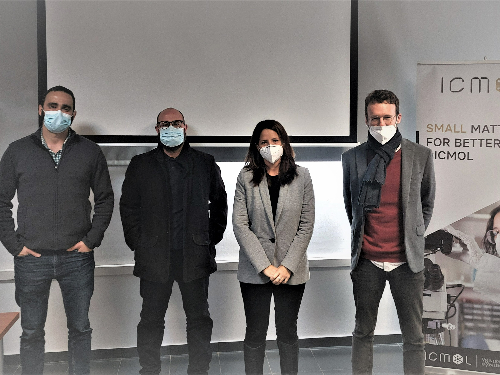
The Institute of Molecular Science (ICMol) of the University of Valencia resumed its #ICmolBreakfast and Innovation programme, specially designed to strengthen ties between the centre's research groups and companies from different industrial areas. The session was devoted to the impact of chemistry on water treatment.
The main lecturers of the day were the company Depuración de Aguas del Mediterráneo (DAM) and the technological institute AINIA, with two interesting presentations by the head of Innovation of the DAM Group, Silvia Doñate, and Jorge García Ivars, from the Department of Product and Process Technologies of Ainia.
Both were introduced by Manuel Quesada, head of the transfer and innovation area of ICMol. Since 2018, ICMol has the seal of Industrial Innovation Scientific Unit (UCIE) of the Valencian Innovation Agency (AVI) of the Generalitat. The UCIE aims to position ICMol in the network of the regional R&D&I system by strengthening relations and collaborations with other complementary agents and promoting technology transfer to industry.
The choice of water treatment as the theme of the conference is not accidental. The European Green Pact, included in the 2030 Agenda, not only proposes a decarbonisation of the economy but also a new European industrial strategy on circular economy. One of its pillars is the elimination of air, water and soil pollution. With regard to water, for example, it proposes preserving biodiversity in lakes, rivers and wetlands, reducing pollution from excess nutrients or from the action of microplastics and pharmaceuticals.
In her speech, Silvia Doñate noted that water, in her opinion, "is a cross-cutting sector that has a considerable impact on the resilience of a society and that in the Valencian Community it is manifested through the promotion of sustainability with the recovery of water resources and the optimisation of energy efficiency".
Energy recovery from sludge represents an attractive processing route to remove its volatile organic matter. Hence, transforming traditional Water Treatment Plants into resource generation plants is considered a priority. During her speech, the DAM Group's Head of Innovation highlighted the potential of chemistry and new materials in water treatment research.
"Traditionally, the role played by chemistry in our treatment plants has been as an element for waste disposal. However, thanks to the advances made, it has become a tool for producing goods and resources with high added value, in line with the principles of circular economy", said Silvia Doñate.
Jorge García explained that Ainia, with more than 1,600 clients and more than 700 associates, works in different lines of the agri-food sector, but also in waste management and industrial and urban water purification treatments with the aim, among others, of combating the effects of the so-called "emerging pollutants" and advancing in circular economy models.
"Our technological innovation revolves around water, from minimising industrial consumption to recycling and regeneration and recovery through chemical treatments," García said. The objective, always, is to adapt to the limitations established by the regulations, for example, with respect to the agri-food industry, where water is required in better conditions than even for human consumption. Quality criteria "with the aim of converting this wastewater into process water".
Successful projects
Among the initiatives developed by Doñate is the COMPOST-UP project, which develops new applications to transform compost from sewage sludge into a product with high biofertiliser and biostimulant potential. ENZYCLE (Microbial enzymes for the treatment of non-recycled plastic fractions) addresses the presence of microplastics in wastewater and their transformation into high value-added products. And PHOTORED researches the development of catalysts for the transformation of CO2 into synthetic fuels and chemical products of industrial interest.
Doñate developed other projects such as REGENERA, ESENCE or SNIFFDRONE that study innovative technologies to store surplus renewable energy in the form of green hydrogen, techniques to detect and remove emerging pollutants (ECs) from wastewater or to obtain real-time maps of odour concentration in highly complex industrial environments, respectively.
Jorge García cited the LIFE LEMNA project to manage nutrients and reduce the environmental impact generated by pig farm slurry through a combined system of anaerobic digestion and lemna cultivation. From excess nutrients, the system produces a biomass with high protein content to be processed into biofertilisers and livestock feed, as a circular economy model to make production systems more sustainable.
Another, such as bioREFINA, develops new processes for the treatment of horticultural waste with the aim of extracting all its valuable elements from this waste, transforming it into bioproducts with new uses, such as liquid fertilisers for fertigation or biofertilisers rich in amino acids and plant hormones with a microalgal base.
With these new uses for the waste, the fruit and vegetable farm would go from buying fertilisers from third parties to producing its own biofertilisers made from the waste generated, improving its economic and environmental sustainability.
"Action financed by the AVI"
"Action eligible for co-financing by the European Union"


